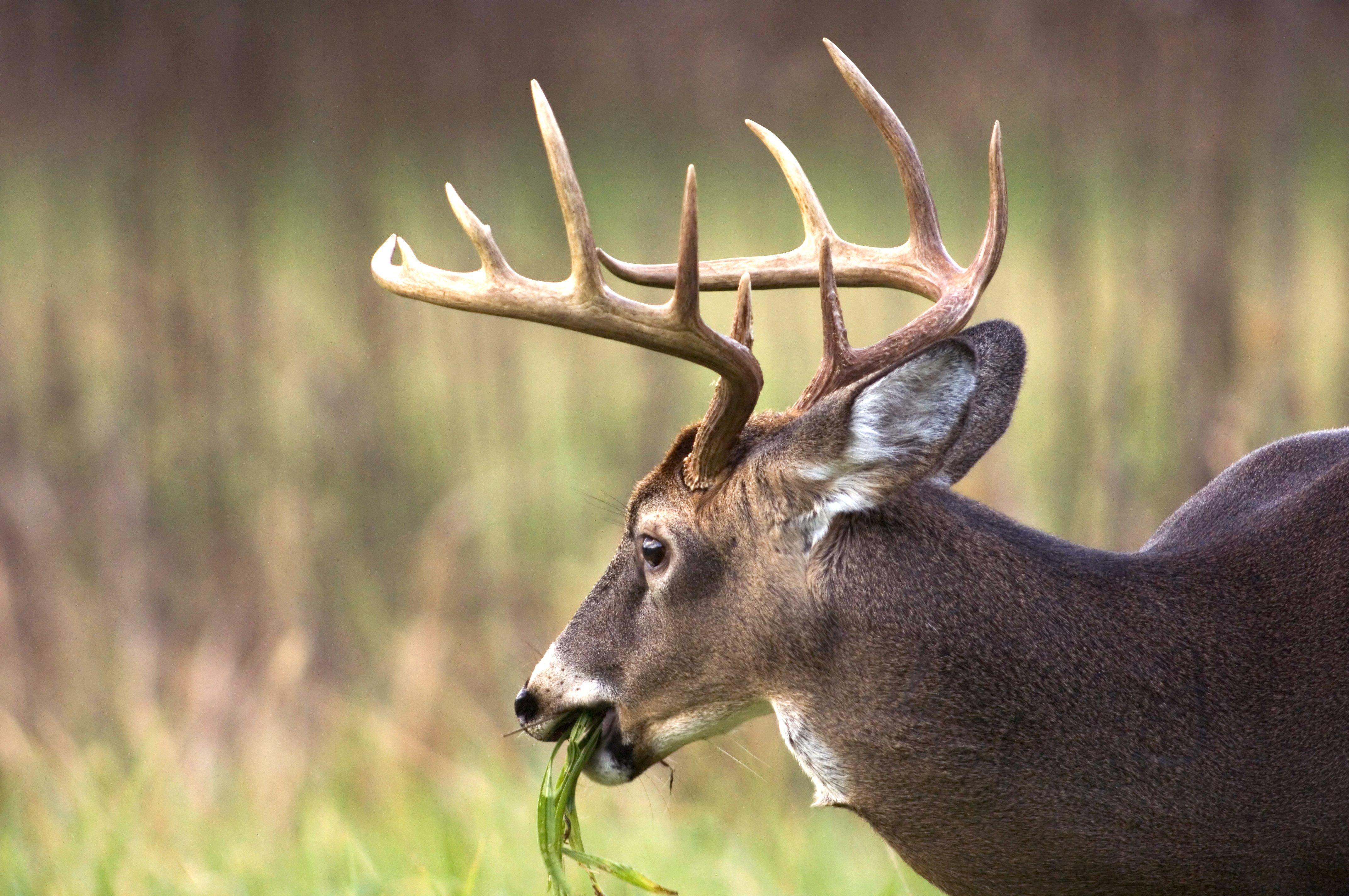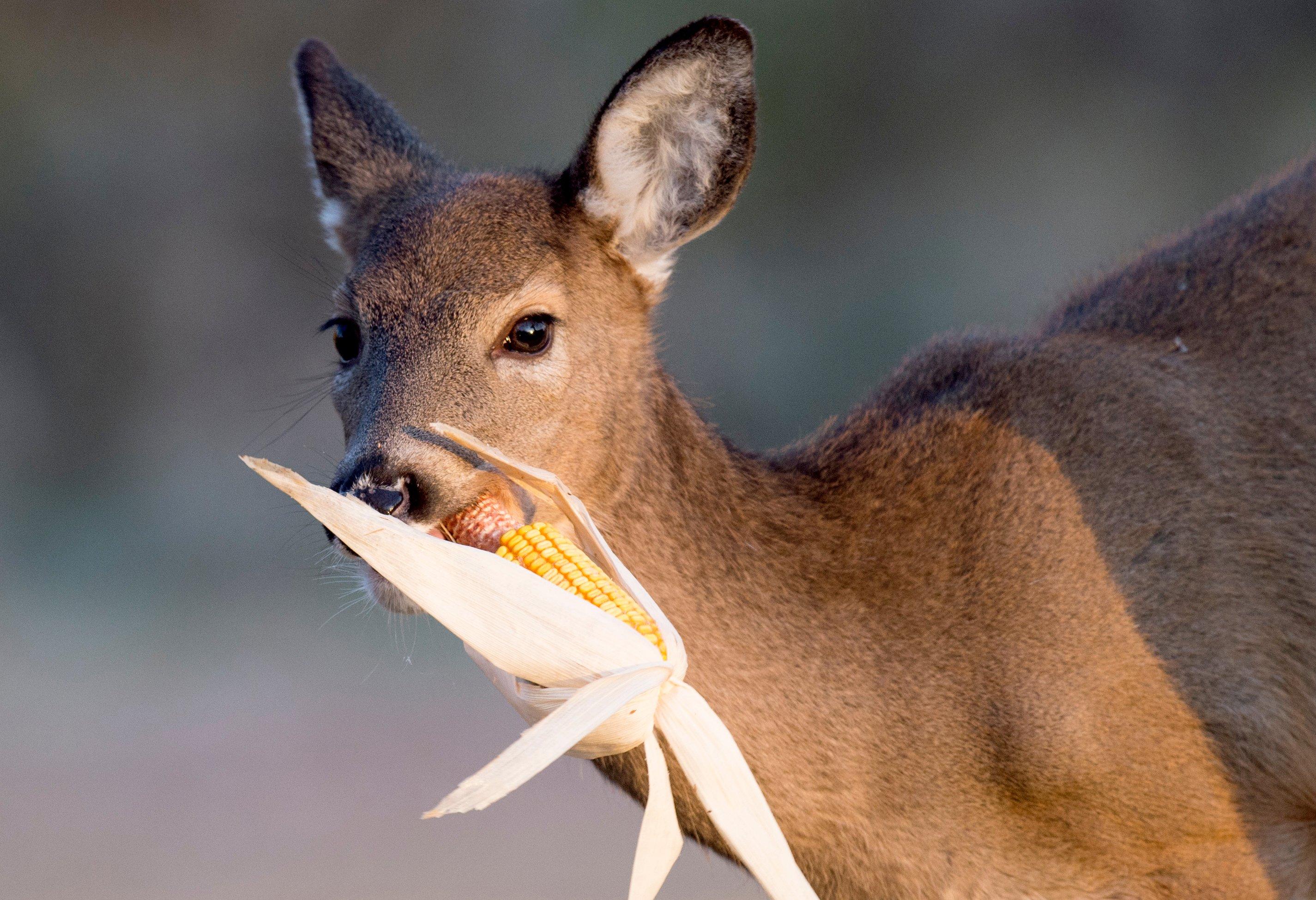Deer focus on several important foods during winter. Learn how to take advantage and fill your late-season tags
Whitetails are driven by four elements: security bedding, food, water, and love. We’re now into the late season, so the last factor is less impactful. The first three reign. Given that most deer have abundant water that’s easy to access, food and good bedding become the limiting factors. So what are the best late-season food sources?

Natural vegetation — including browse, forbs, grasses, hard mast, or soft mast — comprises most of a deer’s nutritional intake. Image by Tony Campbell
Natural Food Sources
Whitetails have diverse diets, but natural foods — such as hard mast, soft mast, browse, and grasses — make up most of their diet.
Hard mast: Chestnuts, red oak acorns, and white oak acorns are the most attractive hard-mast food sources for deer. In areas where ag crops, acorns, and other good foods are limited, don’t overlook the power of beech or hickory nuts.
Red oak acorns are top-shelf late-season food sources. According to the University of Florida Deer Lab, red oak acorns significantly affect late-season whitetail behavior and movement. Dr. Marcus Lashley, with the UF Deer Lab, and Moriah Boggess, a North Carolina deer biologist, simulated a mast crop in a controlled environment. They calculated how many acorns each tree should produce during a typical mast crop year. Then, they distributed the acorns through time, just as the trees would do.
“I took Shumard oak acorns and distributed these under adult trees,” Boggess said. “But there wasn’t a mast crop there that year, so mast wasn’t [naturally] available. We collected 75,000 acorns, placed these under trees, and put out trail cameras to measure deer response.”
Of course, deer prefer white oak acorns over the red oak species. Because of that, and because red oak acorns have higher levels of tannic acid, which acts as a preservative, red oak acorns last longer on the ground. During the study, the red oak acorns sat on the ground for almost two months. Then, when it got cold and other food sources were depleted, deer targeted the red oak acorns heavily.
“As a deer hunter myself, the interesting thing was the deer response to the acorns,” Boggess said. “Deer eat acorns, but not all at the same time. White oak acorns — they eat those as soon as they fall on the ground. But with Shumard oak acorns, we began seeing deer use when we put out those acorns in November. This slowly climbed and had a strong peak in deer use in mid-January.”
What does that mean for deer hunters? Timely opportunity. “Hunting opportunity for all deer, and even mature bucks, increased,” Boggess said. “That’s daylight deer movement. People underestimate red oak acorns as a food source for hunting. If you find the right tree, it can be the best area to hunt in the world. It just requires tree identification knowledge.”
Soft mast: Apples are great fall food sources. But some of them might carry over into the early portion of the late season. That’s especially true for certain apple varieties.
Browse: Browse comes in the form of brushy, shrubby, or woody browse. Deer have been known to eat almost 700 plant species throughout North America, but certain species are better than others. Specifically, remember black gum, duck potato, eastern hemlock, elm, goldenrod, greenbrier, hawthorn, honey locust, honeysuckle, little bluestem, red dogwood, sumac, locust pods, yellow birch, white cedar, and more as great options. If you aren’t great at identifying critical browse species, just sit over a good trail leading to a clear-cut. That should do the trick.
Forbs: These comprise a significant percentage of a deer’s winter diet. Forbs are herbaceous flowering plants upon which deer rely, especially when other options are more limited.
Grasses: Finally, don’t overlook grasses. Although they’re not as nutritious as most other food groups, these still compose a significant portion of a deer’s daily diet.

Corn is a staple in the diet of many ag-country whitetails. Image by Ray Hennessy
Food Plots
In the modern age of land management, food plots are all the rage. And for good reasons. They provide vital nutrition and can produce a lot of forage tonnage. Deer eat green- and grain-based food plots.
Greens: With greens, one group stands out as the premier food plot family. A broad roundup of plant species, brassicas are the top green-based go-to food plot option. These include kale, radishes, triticale, turnips, and more.
Don’t sleep on clover, though. Although it’s usually associated with peak usage during warmer days (think early winter or late winter into early spring), this forb offers a high level of protein and other critical nutrients.
Grains: In winter, deer burn lots of energy. This requires an increased intake level of carbohydrates. Several options stand out. Often confused with ryegrass, cereal rye isn’t a grass but a grain, and deer love it. This carb-rich food source provides loads of energy, which deer need to make it through winter.
Whitetails also load up on another grain: oats (when available). As with cereal rye, these are high in carbohydrates. Oats might not offer as much tonnage as critical greens, but they provide vital nutrition within the food group.
Agriculture
Much of America is in grain crop rotation. More ag acres are converting from beef, dairy, hog, tobacco, and other sectors, and moving into grain-based crop production. Of course, in most cases, that’s a good thing for white-tailed deer.
Alfalfa: Most people think of alfalfa as an early-season food source. Even so, it’s a great late-season option. Often, late-season deer pile into alfalfa fields and ignore other options.
Beets: A staple in parts of the Upper Midwest and Northeast, beets are attractive to deer that are accustomed to them. Planted in new areas, it takes some time for deer to adapt and start eating these. But they will.
Shelled corn: Perhaps the most common late-season offering by hunters for deer, shelled corn is sure to attract whitetails. Baiting is a contentious topic for some, but where it’s legal, it’s practically cultural.
Mowed corn: Where baiting isn’t allowed, a lot of land managers grow corn. They don’t harvest it but instead leave it standing. Then, they legally mow it down for deer. Of course, check your state and local regulations to ensure that’s permitted.
Standing soybeans: Likely the best late-season food source, standing soybeans provide a carb-rich food source that gives deer what they need to thrive. They provide deer with high levels of carbs and protein, and deer don’t have to spend significant amounts of energy to forage the beans.
Wheat: Like alfalfa, wheat offers a green food source for late-season whitetails. It’s abundant and grows easily in most states. It’s a critical diet element for many deer.
The Biggest Factor: Unpressured Cover and Food
Quality food sources are important for whitetails, especially during the late season, when options are limited and available food continues to be depleted. However, good food isn’t the only factor to find deer during daylight. It’s critical to locate unpressured areas that provide pockets of overlooked food and bedding cover. If you do that, you’ll likely fill your remaining deer tag(s) over the best late-season food sources.
Don’t Miss: WANDERING DEER: DO DOES TAKE EXCURSIONS, TOO?











